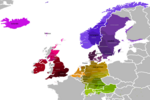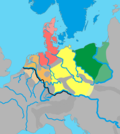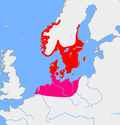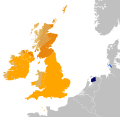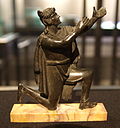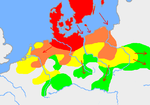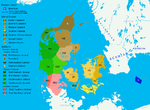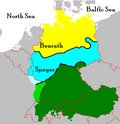The North Germanic languages make up one of the three branches of the Germanic languages—a sub-family of the Indo-European languages—along with the West...
57 KB (5,429 words) - 10:22, 25 March 2024
The Germanic languages are a branch of the Indo-European language family spoken natively by a population of about 515 million people mainly in Europe...
92 KB (9,397 words) - 22:20, 10 May 2024
North Sea Germanic, also known as Ingvaeonic (/ˌɪŋviːˈɒnɪk/ ING-vee-ON-ik), is a postulated grouping of the northern West Germanic languages that consists...
10 KB (1,100 words) - 23:36, 10 May 2024
The Germanic languages include some 58 (SIL estimate) languages and dialects that originated in Europe; this language family is part of the Indo-European...
15 KB (1,120 words) - 00:22, 20 January 2024
The West Germanic languages constitute the largest of the three branches of the Germanic family of languages (the others being the North Germanic and the...
56 KB (4,765 words) - 20:10, 30 May 2024
East Germanic is one of the primary branches of Germanic languages, along with North Germanic and West Germanic. The only East Germanic language of which...
9 KB (917 words) - 19:51, 29 May 2024
Proto-Norse language from around 200 AD, a language that around 800 AD became the Old Norse language, which in turn later became the North Germanic languages of...
91 KB (10,684 words) - 21:22, 29 April 2024
Proto-Germanic (abbreviated PGmc; also called Common Germanic) is the reconstructed proto-language of the Germanic branch of the Indo-European languages. Proto-Germanic...
130 KB (12,145 words) - 15:04, 7 June 2024
The Germanic parent language (GPL), also known as Pre-Germanic Indo-European (PreGmc) or Pre-Proto-Germanic (PPG), is the stage of the Germanic branch...
10 KB (1,243 words) - 18:47, 25 May 2024
themselves evolved into the modern North Germanic languages (Faroese, Icelandic, the Continental Scandinavian languages, and their dialects). Proto-Norse...
22 KB (2,290 words) - 15:40, 2 June 2024
Frisian) varieties of the West Germanic languages. The Anglo-Frisian languages are distinct from other West Germanic languages due to several sound changes:...
23 KB (1,613 words) - 23:57, 27 May 2024
took place separately in various Germanic languages starting around 450 or 500 CE and affected all of the early languages except Gothic. An example of the...
54 KB (5,347 words) - 09:26, 29 May 2024
the use of ancient and early medieval Germanic languages and are thus equated at least approximately with Germanic-speaking peoples, although different...
163 KB (20,170 words) - 04:33, 7 June 2024
which there are eight groups with languages still alive today: Albanian, Armenian, Balto-Slavic, Celtic, Germanic, Hellenic, Indo-Iranian, and Italic;...
111 KB (10,144 words) - 23:35, 7 June 2024
He divides Germanic into a North Germanic and a South Germanic (or Continental Germanic) group, with the Scandinavian (or Nordic) languages and the extinct...
5 KB (567 words) - 22:57, 11 January 2024
Northwest Germanic is a proposed grouping of the Germanic languages, representing the current consensus among Germanic historical linguists. It does not...
10 KB (1,207 words) - 09:46, 7 June 2024
East Germanic groups, and ultimately produced a large group of mediaeval and modern languages, most importantly: Danish, Norwegian, and Swedish (North);...
29 KB (2,932 words) - 11:42, 2 June 2024
Continental Germanic mythology. It was a key element of Germanic paganism. As the Germanic languages developed from Proto-Indo-European language, Germanic mythology...
9 KB (970 words) - 16:27, 5 December 2023
proto-languages. North Sea Germanic Weser–Rhine Germanic Stefan Müller, Germanic syntax: A constraint-based view, series: Textbooks in Language Sciences...
6 KB (483 words) - 05:42, 13 May 2024
linguistics, was too inaccurate to describe the relation between the modern Germanic languages, especially those belonging to its Western branch. Rather than depicting...
6 KB (513 words) - 14:38, 27 March 2024
make up the Anglo-Frisian languages group and together with the Low German dialects these form the North Sea Germanic languages. However, modern English...
33 KB (3,465 words) - 04:54, 6 March 2024
mainly Romance, languages. As a Germanic language, Gothic is a part of the Indo-European language family. It is the earliest Germanic language that is attested...
92 KB (9,677 words) - 19:13, 30 May 2024
Icelandic and retains many features of Old Norse, the source of all North Germanic languages. Since the Act on Greenland Self-Government was adopted by parliament...
5 KB (332 words) - 13:22, 9 January 2024
Low German (redirect from Low Germanic language)
with which it forms the North Sea Germanic group of the West Germanic languages. Like Dutch, it has historically been spoken north of the Benrath and Uerdingen...
133 KB (11,055 words) - 23:23, 7 June 2024
motifs from the early Germanic period. Linguistic reconstructions can be obtained via comparison between the various Germanic languages, comparison with related...
72 KB (1,709 words) - 16:41, 9 May 2024
The Germanic substrate hypothesis attempts to explain the purportedly distinctive nature of the Germanic languages within the context of the Indo-European...
14 KB (1,707 words) - 09:38, 8 May 2024
a list of the languages spoken on the shores of the North Sea. The majority are in the Germanic sub-family of Indo-European languages. In addition, French...
4 KB (220 words) - 09:29, 29 May 2024
research into the Germanic languages began in the 16th century, with the discovery of literary texts in the earlier phases of the languages. Early modern...
4 KB (356 words) - 21:40, 9 March 2024
the time period after the Germanic languages had become distinct from other Indo-European languages (early Iron Age). Germanic paganism covers a period...
128 KB (15,973 words) - 21:50, 30 May 2024
High German consonant shift (redirect from High Germanic languages)
Proto-Germanic, the resulting language, Old High German (henceforth, OHG), can be neatly contrasted with the other continental West Germanic languages, which...
61 KB (6,464 words) - 22:30, 4 June 2024


